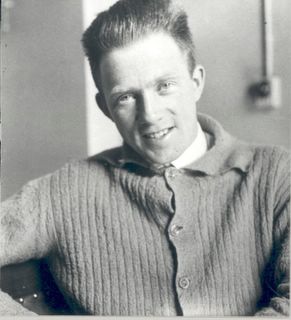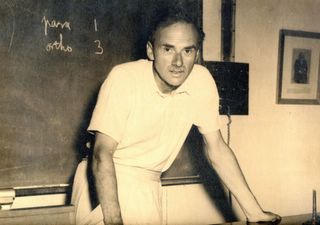
So we need a new theory to describe some of this stuff that doesn't make sense within classical physics. It turns out that in one year three men came up with theories to do this - Schrodinger (above), Heisenberg (below), and Dirac (bottom). Turns out each theory is correct. Ultimately Dirac shows that the other two theories are special cases of his theory. Feynman comes up with another approach later on. For some reason Schrodinger's equation is the most popular in physics books. All 4 are useful under different types of situations.
Shrodinger's equation is a differential equation that solves for a strange quantity called Psi. We'll get to that later. Heisenberg uses matrices to accomplish the same thing. Dirac uses vectors in a multi-dimensional space. And Feynman uses an integral approach. It's not important to show the equations. They are not that messy but messy to understand and messier to solve for.
What is important is what they describe. Let's stick with Schrodinger's equation. Solve Schrodinger's equation and you have a scalar quantity Psi which is a function of time and space. The function always has wave-like properties which led Schrodinger to think he had created an equation that described real waves (like Maxwell's equations). What did the function describe?

Let's take a step back. Classical physics thought that objects had, at any given moment, well-defined attributes - charge, spin, momentum, position, etc. Quantum theory suggests that this is not true. Objects have some static attributes and also some dynamic attributes. Mass, charge and spin are static. There is nothing quantum about them. Everything else, like energy, momentum, and position are dynamic. An object does not innately have these attributes. They are contextual. What attribute an object has depends on how you measure it.
Let's be more specific. Take position. Until an electron is measured, quantum theory says it does not have an innate location in space. When a Copenhagenist says that "there is no deep reality", he/she means that the electron does not have a specific location in space before we identify where it is.
Why don't we experience this in real life? Because as long as we don't push the limits of the electron (like forcing them through a tiny, tiny hole) it will behave relatively classically. It is only for this reason that classical physics performed so well for so long. So what is Psi? Psi is a condensed representation of all those dynamic attributes. If you have Psi you have all information regarding dynamic attributes. You just need to extract the attribute you are interested in. How do you do that? We'll get to that later. We need more background to do that.
Let's instead change subjects. Let's talk about some experiments that show quantum effects. First let's lay out the apparatus for our experiments. An electron gun (something to spew out electrons), some controls (the number of electrons and the velocity they get spewed out), and a phosphor screen (lights up where an electron hits it). We'll be aiming the gun at the screen. An electron spews out of the gun, travels the distance to the screen, excites the phosphor where it hits, and we see a glow (we know an electron hit). Turn up the number electrons being spewed and the glow is more intense. Turn it down and we eventually see individual glows as individual electrons hit the screen.
Experiment 1 - Small Hole
Let's introduce a shield between the phosphor screen and the gun. In the shield we'll have a small hole that the electrons can pass through. The hole will have a movable aperture on it so we can make the hole larger and smaller. Open the hole wide to start. We send through a stream of electrons and we see a large glowing circle on the screen. We slowly decrease the aperture and the circle decreases in size. At some point as we decrease the aperture the circle doubles back and gets larger again. Note, this is when the quantum effects are showing themselves (we'll explain it when we talk about Heisenberg). As we keep decreasing the aperture the circle keeps getting larger but then starts to take on circular striations (think of a bullseye).
This bullseye pattern is called the Airy Pattern. It was described by Airy back in the early 1800s when he was looking at light. It's caused by the destructive and constructive interference between light waves traveling at different points through the aperture. But wait a second... We aren't looking at light, we're looking at electrons. Something we before thought of as particles. Clearly this is the particle wave duality we talked about before. The interference is caused by the electrons' waves interfering with each other. Or is it?
Let's try something else. Let's turn down the knob that controls the number of electrons that are spewing out. Way down. To the point that only 1 electron comes out every minute. It's hard to see what kind of pattern the 'hits' look like now so let's put some photographic paper on the phosphor screen that will record the points of impact.

We come back at the end of the day and process the photographic paper. What do we see? The Airy Pattern. Now think about this. A single electron goes through at a time. How does it interfere with the other particles? There are no other particles right? What is it interfering with? It's interfering with itself. The electron is clearly no longer a particle - a ordinary object. It must be a pure wave that spreads out as a field does and interferes with itself like a light wave does. The electron is no longer confined to a singular location in space but must somehow be 'smeared' out over space. And yet when it hits the screen we only see it hit in one spot - one location.
In other words, when we 'observe' the electron, it is a particle. Before that it is a wave. The nature of the electron is dependent on our observation. We should really say the electron has an unmeasured-wave / measured-particle duality.
Now let's touch on Heisenberg's Uncertainty Principle. We'll come back later in more detail. In quantum mechanics attributes have partners. Energy is linked with time. Momentum is linked with position. These are called conjugate attributes. The Uncertainty Principle says precision measurements in one attribute decreases the precision we can measure the other attribute. So for example,
(accuracy in momentum)*(accuracy in position) is less than a constantIncrease the measurement accuracy (or more precisely decrease the variances) of the position of an electron and our ability to measure the momentum accurately decreases.
Now a couple of important points:
- Most people incorrectly say that the Principle says position and velocity cannot be known to a certain degree of accuracy. It's momentum not velocity. Mass can change due to relativistic effects.
- The Principle extends beyond just these two attributes. Measure the energy to a fine degree of accuracy and you can no longer say with precision when it had that energy (time). In theory there are an infinite list of other conjugate attributes that obey this inequality.
- It is also wrongly stated that our measurement of the electron (usually stated in examples as being done with a light wave to 'see' where the electron is) disturbs the electron's momentum and that is why we cannot know with greater precision what the electron's momentum value is. Wrong. Even if I had some imaginary measuring system that didn't disturb the electron's momentum like light would, we still would not be able to know it's momentum with any greater accuracy than the Principle states. It is not an experimental problem. It is a fact of quantum theory. I see this mistake all the time in quantum books. Stop reading them if they say this. They're crap.
- This does not mean that we cannot know the position for example to a great degree of accuracy. It is simply saying that we cannot know both position and momentum to a great degree of accuracy. It's like squeezing a balloon. Narrow the error in our position measurement and it starts to bulge out the error in our momentum measurement.
- This tradeoff in knowing conjugate variables accurately actually behaves like an engine. Put an electron in a tiny box (we now know it's position to some accuracy and the momentum variability has to increase. In other words the electron starts to bounce around with greater and greater force.
At some point our accuracy improves so much that the variance in the possible momentums (see the equation above) must increase to maintain the inequality. Think about what this means. The variance or distribution of possible momentums for the electron increases as the aperture shrinks. Specifically it increases in the radial direction from the holes center (perpendicular to the direction of the electron) since that is where we're gaining the position accuracy. This increase in the distributions of momentums means some percentage of electrons have a very large momentum and thus shoot off to the side more. This is what increases the size of the circle - some electrons gaining momentum away from the straight path the electron normally would have taken. Awesome!
Part 1 Part 2 Part 3 Part 4 Part 5 Part 6 Part 7 Part 8 Part 9 Part 10

2 comments:
you are now immortal
I believe that goes without saying :)
Post a Comment